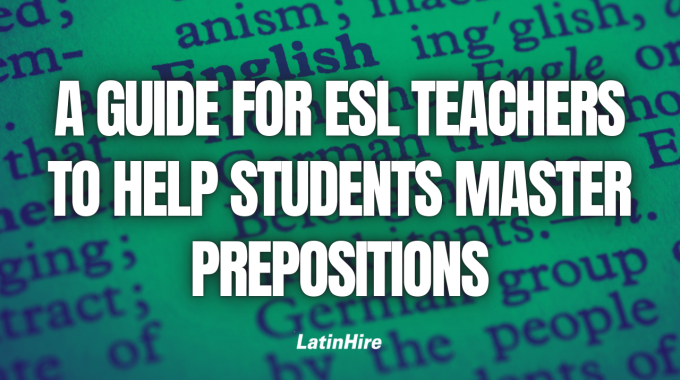Learning a new language is a challenging yet rewarding experience. In our increasingly globalized world,…

A Guide for ESL Teachers to Help Students Master Prepositions
Prepositions are some of the most commonly used words in the English language, but also some of the most confounding. They are small words with a big impact in our daily conversations and are crucial for students to master for fluency in English.
Here’s a comprehensive guide to help your ESL students conquer prepositions with ease and confidence.
First of all, what are prepositions?
Prepositions are words that link nouns, pronouns, or phrases to other words within a sentence. They indicate relationships in time, place, direction, and more. Common prepositions include words like “in,” “on,” “at,” “by,” “with,” “under,” “over,” and “between.”

Teaching Strategies
1) Introduce Prepositions Gradually
Start with the most common prepositions. Focus on one category at a time, such as prepositions of place (in, on, under, next to, behind, in front of, between) before moving onto prepositions of time (at, on, in).
Example Activity: Use visuals, such as showing pictures and asking students to describe them using prepositions. (E.g. “The book is on the table.”)
2) Contextual Learning
Teach prepositions within the context of complete sentences rather than in isolation. This helps students understand how prepositions function within the structure of a sentence.
Example Activity: Read short stories or dialogues and highlight the prepositions used. Discuss how they affect the meaning of the sentences.

3) Use Real-Life Scenarios
Relate prepositions to real-life situations to make learning more practical and memorable.
Example Activity: Do a virtual scavenger hunt where students have to find objects in their environment and describe their locations using prepositions. (E.g. “The shelf is beside the bed.”)
4) Interactive Games
Incorporate games and interactive activities to make learning fun and engaging.
Example Activity: Create bingo cards with different prepositions. Call out sentences, and students mark the prepositions they hear on their cards.
5) Practice, Practice, Practice
Regular practice is key to mastering prepositions. Provide plenty of exercises, quizzes, and homework assignments that require the use of prepositions
Example Activity: Provide sentences with missing prepositions and have students fill in the blanks. (E.g. “She is going __ the store.”)
Common Challenges and Solutions

1) Confusing Similar Prepositions
Prepositions like “in” vs. “on or “at” vs. “in” can be tricky. Provide clear explanations, photos, and examples to differentiate them.
Solution: Create comparison charts and show the differences using visual aids to reinforce the distinctions.
2) Overgeneralization
Students might overgeneralize preposition usage based on their native language.
Solution: Highlight exceptions and provide examples to illustrate different contexts where specific prepositions are used.
Mastering prepositions is essential for ESL students to achieve fluency in English. How do you teach prepositions to your ESL students? Share some of your ideas in the comments below!



